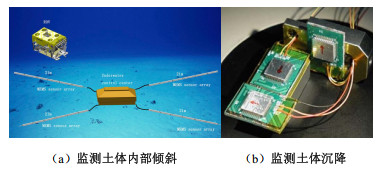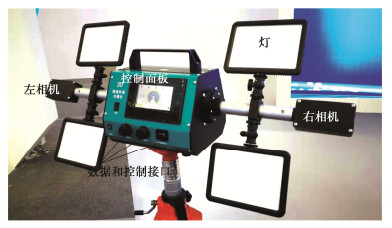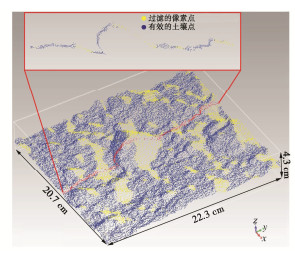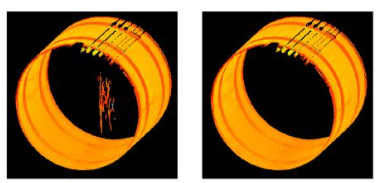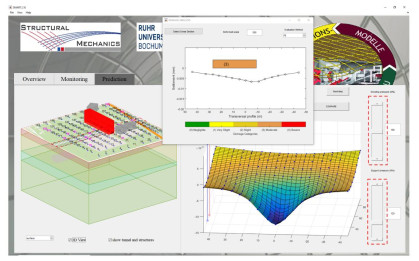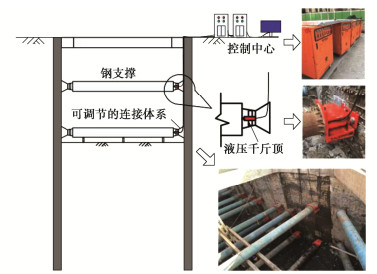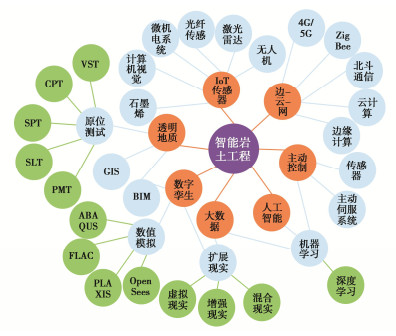Intelligent geotechnical engineering
-
摘要: 以物联网、现代通讯、大数据、人工智能等技术为核心的第四次工业革命成为了众多研究领域智能化升级的平台,新时代条件下传统岩土工程研究遇到了前所未有的机遇和挑战,岩土工程与最新的信息技术、计算机科学技术相互融合,如建筑信息模型、物联网、人工智能、深度学习、增强现实等可实现岩土工程的智能化转型。研究初步构建了“智能岩土工程”的知识图谱,探索了相应的实现路径,阐述了基于新技术的三维地质建模–物联网–深度学习–扩展现实的岩土工程智能化转型方法;介绍了建筑信息模型(BIM)与地理信息系统(GIS)一体化的三维地质建模、“端–边–云–网”的技术架构、以主动伺服加载系统为代表的岩土工程(深基坑工程)风险主动控制系统;阐明了物联网传感器技术在岩土工程领域的应用情况、虚拟现实与增强现实技术在岩土工程领域的应用现状;分析了人工智能(深度学习)在岩土工程风险预测预警方面的关键作用;构建了未来智能岩土工程的知识图谱,为拟从事智能岩土工程相关的研究人员提供借鉴。Abstract: The fourth industrial revolution based on the core technologies of Internet of Things (IoT), modern communication, big data and artificial intelligence (AI) is an upgrading platform for many different research fields. The traditional geotechnical engineering has great opportunities and grand challenges in this new era. Integration of the geotechnical engineering, innovative information technology and computer science technology such as building information modelling (BIM), IoT, AI, deep learning and argument reality can be used to realize intelligent transformation of the traditional geotechnical engineering. The knowledge mapping of the intelligent geotechnical engineering is preliminarily established, and the relevant realization paths are investigated. The transformation method for the intelligent geotechnical engineering "3D geological modelling-IoT-deep learning-extended reality" based on the innovative technologies is depicted. 3D geological modelling using the fusion of BIM and the geographic information system, the technological frame of "end-edge-cloud-network" and the active risk control for geotechnical engineering (deep excavation engineering) based on the active servo-loading system are introduced. The application status of the IoT sensoring technology visual reality and argument reality in the geotechnical engineering is introduced. The key role of AI (deep learning) in the geotechnical engineering for monitoring and early warning is analyzed. The knowledge mapping of future development of the intelligent geotechnical engineering is proposed, providing advice and guidance for the relevant researchers in the geotechnical engineering.
-
0. 引言
随着筑坝材料的最大粒径越来越大,高坝筑坝料的最大粒径已经超过800 mm[1],常规土力学试验设备无法直接用于研究原筑坝料的变形特性[2-3]。为了解决试验粒径限制的问题,通常将原级配堆石材料进行缩尺得到替代原级配材料,然后对缩尺料进行试验,进而确定原型坝的变形特性[4]。然而,一些研究成果及监测资料都表明,缩尺前后粗粒料的力学特性有较大差异,缩尺后粗粒料的力学特性并不能完全反应原级配粗粒料的力学性质[5]。因此,如何确定原级配筑坝材料力学参数,是准确预测坝体变形的一个重要因素。
对此,国内外学者进行大量的大尺寸三轴试验。Marachi等[6]对不同最大粒径的堆石料进行三轴试验得出,大粒径较小粒径压缩性更大。Hunter等[7]积累了大量的不同粒径堆石料坝体的变形监测结果,提出堆石料的压缩模量是随粒径的增大而减小的。Varadarajan等[8-9]对堆石料和砂砾石料分别进行不同缩尺条件下的对比试验,得出堆石料模量随粒径增加而降低,而砂砾石料的模量则随粒径增大而增加。汪小刚[10]根据堆石料在压缩中可破碎和砂砾石料不可破碎的特征,进行了石膏和钢材的不同尺度下的压缩试验,得出与Varadarajan相同的规律。
不同文献所反映的缩尺试验结果可能与缩尺方法、密度、侧限条件、荷载及母岩等有关,但笔者认为将筑坝材料整体上分为可破碎的堆石料和不可破碎的砂砾石料分开研究是理清目前尺度效应研究的途径,同时为避免各种因素的交叉影响,本文基于接触变形理论、室内多尺度试验,研究不同粒径尺度、不同试样尺度、不同侧限条件、不同干密度、不同破碎条件、不同荷载等级等多种组合影响下变形模量的演化规律和内在机理,以此为基础建立多尺度变形参数的统一修正模型,为解决坝体变形预测不准确提供新的思考方法与解决途径。
1. 颗粒材料尺度效应理论分析
1.1 基本理论
(1)基本假定
以理想弹性力学作为计算理论基础;接触表面的摩擦力可忽略不计。
(2)变形方程
点接触物体受力后其接触表面为椭圆;线接触物体受力后其接触表面为矩形。符合变形连续条件。
(3)物理方程
服从弹性虎克定律,接触表面上应力的变化规律与接触体的应变成线性关系,应变最大的接触面中心压应力最大。根据接触表面压应力分布规律求得表面接触压力所组成的合力应等于外加载荷。
1.2 弹性体接触变形分析
设两圆球体的半径分别为R1,R2,开始时在公切平面上的O点相互接触,如图1所示。
在两球的子午面截线上,与z1和z2相距距离r处的两点M和N两点的距离为
Z1+Z2=12(1R1+1R2)。 (1) 设w1表示球体1面上的点M由于局部变形所产生的沿Z1轴方向的位移,w2表示球2面上的点N由于局部变形所产生的沿Z2轴方向的位移,两球的中心O1、O2彼此接近的距离为δ。由于对称性,由接触产生的压力q和位移w对于接触中心O都是轴对称的,计算出最终。由此可以计算出:
q0=3P2πa2, (2) a3=34⋅R1R2R1+R2(1−μ21E1+1−μ22E2)p, (3) δ3=916⋅R1+R2R1R2(1−μ21E1+1−μ22E2)2p2。 (4) 式中 q0为接触中心的压力最大;a是接触圆半径;E1,μ1,E2,μ2分别是两个弹性体弹性常数;p为压力分布函数;δ为变形量;R1,R2分别是两个弹性体半径。
由上式得出,最大接触压应力与载荷不是线性关系,而是与载荷的立方根成正比,这时候因为随着载荷的增加,接触面积也在增大,其结果使接触面上的最大压应力的增长较载荷的增长为慢。
当弹性体与平面接触变形时,则可以将R1=R,R1=∞,E1=E2=E,μ1=μ2=0.3代入式(2)~(4)求解,得到下式:
q0=0.3883√PE2R2, (5) a=1.1093√PRE, (6) δ=1.2313√P2E2R。 (7) 当计算两等直径弹性体接触时,则可将R1=R,R1=∞,E1=E2=E,μ1=μ2=0.3代入式(2)~(4)求解。
a=1.1093√PRE, (8) δ=1.2313√2P2E2R。 (9) 1.3 粒径尺度对压缩模量影响研究
首先研究固定试样尺寸,改变材料的最大粒径情况下对压缩模量的影响,从材料的粒径改变揭示压缩模量的变化规律。推导假定为:在相同加载试样尺寸内,材料从单个半径为R的弹性体逐渐减小其半径,分别为R/2,R/4,R/6,…,R/1000,如图2所示。在此过程中密度保持不变,空间内的孔隙率保持不变,荷载等级保持不变,无侧限条件,受荷载P的作用下,逐步分析粒径逐渐缩小所引起的弹性模量的变化。
利用1.2节理论推导结果,计算图2中不同粒径下的变形量,进而计算更小的最大粒径下变形量,形成归一化压缩模量。此处定义归一化压缩模量含义为:设未进行缩尺时试件的压缩模量初始值为1,缩尺后压缩模量与初始压缩模量之比为归一化压缩模量。
为更直观表达级配组构条件下粒径尺度对压缩模量的影响,将初始最大粒径设为1000 mm,对应的压缩模量归一化为1,并化为无量刚量,则随着粒径的减小,建立如图3所示关系。
建立粒径尺度与归一化压缩模量的关系如下式所示:
Egd=0.5691+0.2116e−ξ9.9617+0.2374e−ξ212.3621, (10) 式中,Egd为粒径尺度归一化模量,ξ为固定试样尺寸条件下的归一化粒径。
1.4 试件尺度对压缩模量影响研究
对于有级配组构情况下,首先确定组构规则,根据圆形几何组构规则,空隙部分首先用最大半径进行组构,组构后每个空间为三边形,在此三边空隙内继续组构,直至R/1000。组构弹性体的粒径符合指数递减规律,并形成悬浮型颗粒构架体系,同时构建最接近实际情况下的级配曲线,悬浮级配构建如图4所示,与之对应的级配曲线如图5。
为从材料的试样尺度角度揭示加载试验的面积改变对压缩模量的影响,逐渐增大试样尺度,分别为2R,4R,6R,…,1000R,求解在不同荷载加载面积下的压缩模量,如图6所示。
根据不同试样尺度条件下的归一化压缩模量,引入径径比的概念,既试样尺寸与最大粒径之比,建立径径比与压缩模量的关系如图7所示。可得出,当径径比大于5时,归一化压缩模量变稳定,从理论角度论证了压缩试验可靠性的必要条件。
2. 变形特性的外部影响因素研究
2.1 侧限条件对压缩模量的影响
对侧向不允许变形的压缩弹性体,取一个单元进行分析其弹性阶段受力变形。该单元受到三向应力
σx ,σy ,σz 作用,在z方向的压力作用下,试样中的竖向有效应力为σz ,又因为试样的受力条件属于轴对称问题,故水平向有效应力σx =σy ,由于土体的侧向变形被限制住,故εx =εy = 0,于是:εx=σxEs−μσyEs−μσzEs=0, (11) 式中,E,Es分别为无侧线和完全侧限条件下的模量,μ为组构材料的泊松比。μ取0.3时,建立完全侧向与无侧限模量的关系为
Es=1.346E。 (12) 由此可得完全侧向与无侧限模量随粒径整体的增大倍数,在μ取0.3时增大约35%。
2.2 干密度与压缩模量的关系研究
本研究推导成立的边界条件是从原型尺度到实验室尺度均保持同样的干密度或孔隙比,而在实际室内试验中,由于粒径的缩小通常表现为筑坝原型干密度大,而室内实验试件的干密度小,且很难使压缩试件的干密度达到现场的大小,这就为实现同密度或孔隙率条件下的室内试验造成一定的障碍。为解决这一障碍,找出室内试验密度或孔隙率与压缩模量的关系,采用此规律修正后即便在密度未达到原型密度下亦可进行实验并进行回溯。
对若干个工程的材料均进行不同干密度下的压缩试验,建立如图8所示趋势图。
建立如下式所示的关系。
f(ρd)=2.331+0.702−2.3311+(ρd1.996)29.891, (13) 式中,
f(ρd) 为受密度影响下试样的压缩模量,ρd 为干密度。2.3 颗粒边缘破碎影响分析
为分析堆石料破碎与粒径间的关系,在单一粒径情况下假定大小颗粒的粒径在特定比例下,某一应力状态中发生破碎,保持该应力状态不变,不断减小最大粒径。计算基本参数为:大粒径与小粒径之比为20,在缩小大粒径过程中,保持该比例不变。
图9不同粒径下的试样破碎变形计算。由式(2)~(4)可计算小粒径上的最大应力。在粒径不断缩小的过程中,单个小颗粒承受的外部应力会逐渐减小,化为等效破碎变形量,建立破碎量与粒径变化如图10所示。
该曲线采用函数表示为
δ=1.023e−D42.848。 (14) 2.4 荷载等级对压缩模量影响研究
为了解荷载等级对压缩模量的影响关系,在有填充条件下,分别计算半径为R/n的弹性体,在有填充作用下分别受荷载2p,3p,4p,…,10p作用下的压缩模量。压缩模量的增大倍数仅与荷载大小直接相关,绘制压缩模量与荷载等级趋势关系如图11所示。并可用下式:
f(p)=2.7354−1.9981e−Pi6.4893, (15) 式中,
f(p) 为荷载影响下的压缩模量放大倍数,pi为荷载等级倍数,为当前加压等级与初始加压等级的比值。3. 堆石料多尺度统一修正模型的建立
3.1 模型的提出
多尺度统一修正模型在于将缩尺材料的压缩模量求解为筑坝原型材料的压缩模量,在此过程中综合考虑缩尺过程、荷载等级、干密度和侧限状态、破碎效应的影响,对此提出涵盖此参数的统一修正模型公式为
F(ξ,p,ρd,μ,D)=f1(ξ)⋅f2(pi)⋅f3(ρd)⋅f4(μ)⋅f5(D)。 (16) 式中
f1(ξ) 为粒径影响下的的回溯函数;f2(pi) 为荷载等级影响下的修正函数;f3(ρd) 为干密度影响下的修正函数;f4(μ) 为泊松比影响下的侧限修正函数。f5(D) 为粒径影响下的破碎修正函数。根据回溯过程,建立粒径尺度和试样尺度影响下归一化压缩模量的关系,如图12所示。具体函数关系为
f1(ξ)=A1+A2−A11+(ξ1/A3)A4A1+A2−A11+(ξ0/A3)A4⋅B1+B2e−ξ2B3+B4e−ξ2B5B1+B2e−ξ1B3+B4e−ξ1B5⋅A1+A2−A11+(ξ3/A3)A4A1+A2−A11+(ξ2/A3)A4。 (17) 式中 Ai表示固定材料最大粒径下,试样尺寸对归一化压缩模量的影响系数;Bi表示固定试样尺寸条件下材料粒径变化与归一化压缩模量的系数;ξ为转换过程的粒径。
3.2 基于外部影响因素的统一修正
(1)泊松比影响下的侧限修正
侧限条件是筑坝料变形应力状态的具体描述,侧限所引起的压缩模量改变可通过泊松比表示,泊松比对压缩模量的影响关系,可用下式表示:
f4(μ)=1−2μ21−μ, (18) 式中,μ为筑坝料的泊松比,可通过压缩试验获取。
(2)干密度影响下的修正
由2.4节所提出的干密度对变形模量的影响模型,可得到在未达到原型密度下的回溯。如下式所示:
f3(ρd)=D1+D2−D11+(ρd/D3)D4, (19) 式中,Di(i=1,2,3,4,)为待定系数,
ρd 为干密度。(3)破碎效应影响修正
筑坝材料整体上可分为可压缩破碎的堆石料和不破碎的砾石料,当采用堆石料筑坝时,往往表现出粒径越大压缩模量越低的情况,由此引入破碎效应的修正,如下式。当采用砂砾石料时不发生材料颗粒破碎,可不考虑破碎效应。
f5(D)=αeD/r, (20) 式中,D为最大粒径,
α ,r 为待定系数。(4)荷载等级影响下的修正函数
对于筑坝料,其压缩模量与试验施加的荷载应力大小有关,表现为荷载应力水平越大压缩模量越大,呈非线性正相关,具体如下式表示:
f2(pi)=C1+C2eC3ρd, (21) 式中,Ci为受荷载等级影响下的压缩模量关系的非线性表达系数。
综合以上各影响因素,选取实际试验中所涉及到的情况进行选用。
3.3 多尺度统一修正模型的应用
以河口村大坝为例,坝体为混凝土面板堆石坝,最大坝高122.5 m,面板堆石坝设计主要考虑的因素是大坝的应力变形状态,而大坝应力变形分析的主要手段是有限元数值分析。将室内缩尺三轴试验所得E-B模型参数进行的坝体沉降计算与经统一修正模型修正后的模型参数计算结果进行对比,并与工程监测值相校核。
主要考虑主堆石料计算参数的影响,主堆石区填筑材料为级配碎石,室内三轴试验所得主应力差与轴向应变如图13所示。根据该三轴试验结果计算主堆石材料的E-B模型参数如表1所示。采用该参数计算所得最大竖向沉降竣工时61.2 cm,蓄水期68.1 cm。
表 1 修正前后河口村主堆石材料E-B模型参数Table 1. E-B model parameters of main rockfill materials in Hekou Village分类 干重度/(kN·m-3) K n Rf Kur c/kPa φ0/(°) Δφ/(°) Kb m 修正前 20.7 1660 0.21 0.85 3320 0 54 10.6 380 0.14 修正后 20.7 1312 0.25 0.82 3320 0 54 10.6 581 0.14 本文的模型最要考虑变形参数的影响,E-B模型中与变形相关的过程量为Ei,根据三轴试验过程和材料属性,采用统一修正模型进行尺度及各影响因素的影响系数计算,如表2所示。
表 2 河口村主堆石材料修正计算Table 2. Correction calculation of main rockfill materials in Hekou Village项目 f1(ξ) f2(μ) f3(ρd) f4(D) f5(p) 综合影响F(·) 修正值 1.19 1.0 1.47 0.56 1.0 0.84 采用表2中修正后的E-B模型参数,计算总体沉降量对比如表3所示。
表 3 河口村坝体沉降计算对比Table 3. Comparison of settlement calculation of Hekou Village Dam项目 计算最大沉降/cm 提升准确度/% 竣工 蓄水 室内缩尺试验 61.2 68.1 监测数据 78.9 109.7 17.43~28.89 统一修正模型 75.6 99.7 4. 结论
针对筑坝料的变形特性的尺寸效应,以接触变形理论为基础,从粒径尺度、试件尺度及外部影响因素角度,结合试验的方法进行了研究,主要得到以下结论:
(1)基于弹性力学接触变形理论,建立了粒径尺度与归一化压缩模量的指数相关模型,论证了试件尺度中径径比大于5时压缩试验的变形可靠性。
(2)揭示了与尺度效应相关的5个外部因素,侧限条件、干密度、边缘破碎及荷载等级等多种组合对变形特性的影响规律和内在机理,并分别建立了各因素与变形的相关模式。
(3)基于试验回溯现场过程,建立了综合考虑缩尺过程、侧限条件、干密度、边缘破碎及荷载等级因素下的多尺度变形参数统一修正模型。
(4)通过对大坝堆石料变形E-B模型计算参数的修正及变形计算,验证了多尺度变形参数统一修正模型的适用性与可靠性,较直接采用缩尺试验结果准确度提升了约20%。
-
图 3 隧道图像测量设备[21]
Figure 3. Measurement devices for tunnel topography
图 4 沿激光扫描仪视线拍摄的地面混合像素横截面[24]
Figure 4. Example of automatically-detected mixed pixels in a single scan station
图 5 激光扫描仪获取的隧道点云图与处理方法[28]
Figure 5. Obtained point cloud of a tunnel
-
[1] 赵艳莉. 基于计算机三维地质模型的岩土工程设计与可视分析——评《岩土工程勘察与设计》[J]. 岩土工程学报, 2019, 41(7): 1381. https://www.cnki.com.cn/Article/CJFDTOTAL-YTGC201907028.htm ZHAO Yan-li. Based on the design and visual analysis of geotechnical engineering based on computer three-dimensional geological model[J]. Journal of Geotechnical Engineering, 2019, 41(7): 1381. (in Chinese) https://www.cnki.com.cn/Article/CJFDTOTAL-YTGC201907028.htm
[2] 谭顺辉. 隧道掘进机多功能化及智能化的发展与推广[J]. 隧道建设, 2020, 40(9): 1243–1250. https://www.cnki.com.cn/Article/CJFDTOTAL-JSSD202009001.htm TAN Shun-hui. Development and application of multi-functional and intelligent tunnel boring machine[J]. Tunnel Construction, 2020, 40(9): 1243–1250. (in Chinese) https://www.cnki.com.cn/Article/CJFDTOTAL-JSSD202009001.htm
[3] 陈祖煜, 赵宇飞, 邹斌, 等. 填筑碾压施工无人驾驶技术的研究与应用[J]. 水利水电技术, 2019, 50(8): 1–7. https://www.cnki.com.cn/Article/CJFDTOTAL-SJWJ201908001.htm CHEN Zu-yu, ZHAO Yu-fei, ZOU Bin, et al. Research and application of drive technology of dam filling rolling construction[J]. Water Resources & Hydropower Technology, 2019, 50(8): 1–7. (in Chinese) https://www.cnki.com.cn/Article/CJFDTOTAL-SJWJ201908001.htm
[4] 熊自明, 卢浩, 王明洋, 等. 我国大型岩土工程施工安全风险管理研究进展[J]. 岩土力学, 2018, 39(10): 3703–3716. https://www.cnki.com.cn/Article/CJFDTOTAL-YTLX201810028.htm XIONG Zi-ming, LU Hao, WANG Ming-yang, et al. Research progress on safety risk management for large scale geotechnical engineering construction in China[J]. Rock and Soil Mechanics, 2018, 39(10): 3703–3716. (in Chinese) https://www.cnki.com.cn/Article/CJFDTOTAL-YTLX201810028.htm
[5] 戴妙林, 屈佳乐, 刘晓青, 等. 基于GA-BP算法的岩质边坡稳定性和加固效应预测模型及其应用研究[J]. 水利水电技术, 2018, 49(5): 165–171. https://www.cnki.com.cn/Article/CJFDTOTAL-SJWJ201805024.htm DAI Miao-lin, QU Jia-le, LIU Xiao-qing, et al. Study on GA-BP hybrid algorithm-based prediction model and its application to rock slope stability and reinforcement effect[J]. Water Resources and Hydropower Engineering, 2018, 49(5): 165–171. (in Chinese) https://www.cnki.com.cn/Article/CJFDTOTAL-SJWJ201805024.htm
[6] ONSEL I E, CHANG O, MYSIOREK J, et al. Applications of mixed and virtual reality techniques in site characterization[C]// 26th Vancouver Geotechnical Society Symp. Vancouver, 2019.
[7] WANG R X, WANG R, FU P C, et al. Portable interactive visualization of large-scale simulations in geotechnical engineering using Unity3D[J]. Advances in Engineering Software, 2020, 148: 102838. doi: 10.1016/j.advengsoft.2020.102838
[8] VAN ECK N J, WALTMAN L, VOSviewer Manual[M]. Leiden: Univeristeit Leiden, 2011.
[9] 韩同春, 林博文, 何露, 等. 基于GIS与数值模拟软件耦合的三维边坡建模方法及其稳定性研究[J]. 岩土力学, 2019, 40(7): 2855–2865. doi: 10.16285/j.rsm.2018.0439 HAN Tong-chun, LIN Bo-wen, HE Lu, et al. Three-dimensional slope modelling method and its stability based on coupled GIS and numerical simulation software[J]. Rock and Soil Mechanics, 2019, 40(7): 2855–2865. (in Chinese) doi: 10.16285/j.rsm.2018.0439
[10] VALERIA N, ROBERTA V, VITTORIA C A. A new frontier of BIM process: geotechnical BIM[C]// Proceedings of the Ⅻ European Conference on Soil Mechanics and Geotechnical Engineering, Icelandic Geotechnical Society. Reykjavik, 2019.
[11] ZOU Y, KIVINIEMI A, JONES S W. A review of risk management through BIM and BIM-related technologies[J]. Safety Science, 2017, 97: 88–98. doi: 10.1016/j.ssci.2015.12.027
[12] FABOZZI S, BIANCARDO S A, VEROPALUMBO R, et al. I-BIM based approach for geotechnical and numerical modelling of a conventional tunnel excavation[J]. Tunnelling and Underground Space Technology, 2021, 108: 103723. doi: 10.1016/j.tust.2020.103723
[13] HONG C Y, ZHANG Y F, ZHANG M X, et al. Application of FBG sensors for geotechnical health monitoring, a review of sensor design, implementation methods and packaging techniques[J]. Sensors and Actuators A: Physical, 2016, 244: 184–197. doi: 10.1016/j.sna.2016.04.033
[14] ZHANG C C, SHI B, ZHU H H, et al. Toward distributed fiber-optic sensing of subsurface deformation: a theoretical quantification of ground-borehole-cable interaction[J]. Journal of Geophysical Research: Solid Earth, 2020, 125(3): e2019JB018878.
[15] ZHANG C C, ZHU H H, CHEN D D, et al. Feasibility study of anchored fiber-optic strain-sensing arrays for monitoring soil deformation beneath model foundation[J]. Geotechnical Testing Journal, 2019, 42(4): 20170321. doi: 10.1520/GTJ20170321
[16] SHI B, ZHANG D, HONGHU Z, et al. DFOS Applications to Geo-Engineering Monitoring[J]. Photonic Sensors, 2021, 11(2): 158–186. doi: 10.1007/s13320-021-0620-y
[17] CMIELEWSKI B. Use of low-cost MEMS technology in early warning system against landslide threats[J]. Acta Geodynamica et Geomaterialia, 2013: 485–490. doi: 10.13168/AGG.2013.0049
[18] BENNETT V, ABDOUN T, O'MEARA K, et al. Wireless MEMS-based in-place inclinometer-accelerometer array for real-time geotechnical instrumentation[C]//Engineering Geology and Geological Engineering for Sustainable Use of the Earth's Resources, Urbanization and Infrastructure Protection from Geohazards. Springer, 2018.
[19] KIM J, KWON S, PARK S, et al. A MEMS-based commutation module with vibration sensor for wireless sensor network-based tunnel-blasting monitoring[J]. KSCE Journal of Civil Engineering, 2013, 17(7): 1644–1653. doi: 10.1007/s12205-013-0108-4
[20] XU C Y, CHEN J W, ZHU H C, et al. Design and laboratory testing of a MEMS accelerometer array for subsidence monitoring[J]. Review of Scientific Instruments, 2018, 89(8): 085103. doi: 10.1063/1.5036666
[21] GAO Z R, LI F J, LIU Y, et al. Tunnel contour detection during construction based on digital image correlation[J]. Optics and Lasers in Engineering, 2020, 126: 105879. doi: 10.1016/j.optlaseng.2019.105879
[22] SALOMA UY E E. Image processing for geotechnical laboratory measurements[J]. International Journal of Geomate, 2016, 10(22): 1964–1970.
[23] STANIER S A, BLABER J, TAKE W A, et al. Improved image-based deformation measurement for geotechnical applications[J]. Canadian Geotechnical Journal, 2016, 53(5): 727–739. doi: 10.1139/cgj-2015-0253
[24] MILENKOVIĆ M, PFEIFER N, GLIRA P. Applying terrestrial laser scanning for soil surface roughness assessment[J]. Remote Sensing, 2015, 7(2): 2007–2045. doi: 10.3390/rs70202007
[25] MAZZANTI P. Displacement monitoring by terrestrial SAR interferometry for geotechnical purposes[J]. Geotechnical News, 2011, 29(2): 25.
[26] XU H, LI H B, YANG X G, et al. Integration of terrestrial laser scanning and NURBS modeling for the deformation monitoring of an earth-rock dam[J]. Sensors, 2018, 19(1): 22. doi: 10.3390/s19010022
[27] OSKOUIE P, BECERIK-GERBER B, SOIBELMAN L. Automated measurement of highway retaining wall displacements using terrestrial laser scanners[J]. Automation in Construction, 2016, 65: 86–101. doi: 10.1016/j.autcon.2015.12.023
[28] XIE X Y, LU X Z. Development of a 3D modeling algorithm for tunnel deformation monitoring based on terrestrial laser scanning[J]. Underground Space, 2017, 2(1): 16–29. doi: 10.1016/j.undsp.2017.02.001
[29] LI Z H, FANG L Q, SUN X K, et al. 5G IoT-based geohazard monitoring and early warning system and its application[J]. EURASIP Journal on Wireless Communications and Networking, 2021: 160.
[30] HUDSON T S, BAIRD A F, KENDALL J M, et al. Distributed Acoustic Sensing (DAS) for natural microseismicity studies: a case study from Antarctica[J]. Journal of Geophysical Research: Solid Earth, 2021, 126(7): e2020JB021493.
[31] 江月新, 黄云龙, 余建军. 基于WiFi通信的矿井监测无线传感器网络研究[J]. 煤炭技术, 2017, 36(6): 278–280. https://www.cnki.com.cn/Article/CJFDTOTAL-MTJS201706106.htm JIANG Yue-xin, HUANG Yun-long, YU Jian-jun. Research on mine monitoring wireless sensor network based on WiFi communication[J]. Coal Technology, 2017, 36(6): 278–280. (in Chinese) https://www.cnki.com.cn/Article/CJFDTOTAL-MTJS201706106.htm
[32] DONG W K, LI W G, SUN Z H, et al. Intrinsic graphene/cement-based sensors with piezoresistivity and superhydrophobicity capacities for smart concrete infrastructure[J]. Automation in Construction, 2022, 133: 103983. doi: 10.1016/j.autcon.2021.103983
[33] DAI Y Y, ZHANG K, MAHARJAN S, et al. Edge intelligence for energy-efficient computation offloading and resource allocation in 5G beyond[J]. IEEE Transactions on Vehicular Technology, 2020, 69(10): 12175–12186. doi: 10.1109/TVT.2020.3013990
[34] ARMAGHANI D J, AZIZI A. Empirical, statistical, and intelligent techniques for TBM performance predictionp[J]. Applications of Artificial Intelligence in Tunnelling and Underground Space Technology, Springer, 2021: 17–32.
[35] DING Z, JIN J K, HAN T C. Analysis of the zoning excavation monitoring data of a narrow and deep foundation pit in a soft soil area[J]. Journal of Geophysics and Engineering, 2018, 15(4): 1231–1241. doi: 10.1088/1742-2140/aaadd2
[36] EID A, HESTER J G D, TENTZERIS M M. 5G as a wireless power grid[J]. Scientific Reports, 2021, 11: 636. doi: 10.1038/s41598-020-79500-x
[37] REN J, ZHANG D Y, HE S W, et al. A survey on end-edge-cloud orchestrated network computing paradigms: transparent computing, mobile edge computing, fog computing, and cloudlet[J]. ACM Computing Surveys, 2020, 52(6): 125.
[38] RAWLINGS C. Geotechnical finite element analysis-a practical guide[C]// Proceedings of the Institution of Civil Engineers-Civil Engineering, 2017.
[39] ZHANG W G, ZHANG R H, WU C Z, et al. State-of-the-art review of soft computing applications in underground excavations[J]. Geoscience Frontiers, 2020, 11(4): 1095–1106.
[40] JAFARI M. System identification of a soil tunnel based on a hybrid artificial neural network–numerical model approach[J]. Iranian Journal of Science and Technology, Transactions of Civil Engineering, 2020, 44(3): 889–899.
[41] HASANPOUR R, ROSTAMI J, SCHMITT J, et al. Prediction of TBM jamming risk in squeezing grounds using Bayesian and artificial neural networks[J]. Journal of Rock Mechanics and Geotechnical Engineering, 2020, 12(1): 21–31.
[42] CHEN R P, ZHANG P, KANG X, et al. Prediction of maximum surface settlement caused by earth pressure balance (EPB) shield tunneling with ANN methods[J]. Soils and Foundations, 2019, 59(2): 284–295.
[43] CAO B T, OBEL M, FREITAG S, et al. Artificial neural network surrogate modelling for real-time predictions and control of building damage during mechanised tunnelling[J]. Advances in Engineering Software, 2020, 149: 102869.
[44] QIU H, FANG W, BAO H, et al. A feasibility study of virtual reality technology in guidance design of underground space[C]// International Conference on Applied Human Factors and Ergonomics. Springer, 2021.
[45] CHI H L, KANG S C, WANG X Y. Research trends and opportunities of augmented reality applications in architecture, engineering, and construction[J]. Automation in Construction, 2013, 33: 116–122.
[46] BERTAM J, MOSKALIAK J. Virtual reality training: making construction work safer[J]. Computers in Human Behavior, 2015, 43: 284–292.
[47] XU J Q, MOREU F. A review of augmented reality applications in civil infrastructure during the 4th industrial revolution[J]. Frontiers in Built Environment, 2021, 7: 640732.
[48] HANSEN L H, FLECK P, STRANNER M, et al. Augmented reality for subsurface utility engineering, revisited[J]. IEEE Transactions on Visualization and Computer Graphics, 2021, 27(11): 4119–4128.
[49] 唐德琪, 俞峰, 黄祥国, 等. 开挖诱发坑内既有基桩附加内力的模型试验[J]. 浙江大学学报(工学版), 2019, 53(8): 1457–1466. https://www.cnki.com.cn/Article/CJFDTOTAL-ZDZC201908004.htm TANG De-qi, YU Feng, HUANG Xiang-guo, et al. Chamber tests for investigating additional internal forces in existing foundation piles induced by excavation[J]. Journal of Zhejiang University (Engineering Science), 2019, 53(8): 1457–1466. (in Chinese) https://www.cnki.com.cn/Article/CJFDTOTAL-ZDZC201908004.htm
[50] LI M G, DEMEIJER O, CHEN J J. Effectiveness of servo struts in controlling excavation-induced wall deflection and ground settlement[J]. Acta Geotechnica, 2020, 15(9): 2575–2590.
[51] 赵自强. 深基坑自动伺服系统应用的变形控制分析[C]// 第十五届全国工程物探与岩土工程测试学术大会. 厦门, 2017. ZHAO Zi-qiang. Deformation control analysis of automatic servo system application in deep foundation pit[C]// The 15th National Engineering Property Exploration and Geotechnical Engineering Test Academic Conference. Xiamen, 2017. (in Chinese)
[52] CHEN B G, YAN T F, SONG D B, et al. Experimental investigations on a deep excavation support system with adjustable strut length[J]. Tunnelling and Underground Space Technology, 2021, 115: 104046.
-
期刊类型引用(21)
1. 孟珂,王笑梅,杜晓冉,张晓曼,罗娟. 罕见多矿物晶体共生标本的综合鉴定. 矿产综合利用. 2025(01): 200-205 .  百度学术
百度学术
2. 刘勇,张志康,魏建平,徐向宇,郜英俊. 柔性刀具冲击破煤能量演化及关键参数. 煤炭学报. 2025(02): 965-974 .  百度学术
百度学术
3. 李红丽. 非均质岩石单轴压缩下损伤演化规律数值模拟研究. 有色矿冶. 2024(01): 43-48 .  百度学术
百度学术
4. 鞠明和,陶泽军,蔚立元,姜礼杰,郑彦龙,邹春江. 钢粒子迟滞重复冲击破岩硬岩损伤破裂特征研究. 岩土力学. 2024(04): 1242-1255 .  百度学术
百度学术
5. 吴泽兵,袁若飞,张文溪,王刚,胡诗尧. PDC混合布齿钻头破碎非均质花岗岩数值模拟. 天然气工业. 2024(05): 105-117 .  百度学术
百度学术
6. 周元,吕威帆,王颖轶. 基于块体离散元法的盾构掘进围岩与管片变形模拟研究. 都市快轨交通. 2024(03): 125-134 .  百度学术
百度学术
7. 裴书锋,郝文锋,王营利,王一汀,曾凤娟. 双江口水电站花岗岩单轴压缩微观破坏机制研究. 西北水电. 2024(04): 62-68 .  百度学术
百度学术
8. 张国桥,孙鹏,吴祥业,王婧雅,郭文斌,田宇航. 基于PFC-GBM非均质模型的砂岩裂纹演化细观规律研究. 中国矿业. 2024(09): 158-169 .  百度学术
百度学术
9. 冯龙飞,王双明,王晓东,解嘉豪,窦林名. 煤单轴峰后动态冲击破坏特征及差异机制模拟研究. 煤炭学报. 2024(S2): 714-730 .  百度学术
百度学术
10. 马文强,王酒婷. 花岗岩受压宏-细观破坏特征及能量演化规律. 信阳师范学院学报(自然科学版). 2023(02): 314-320 .  百度学术
百度学术
11. 张涛,蔚立元,苏海健,高亚楠,贺虎,魏江波. 基于多级力链网络分析的花岗岩压缩特性的矿物尺寸效应研究. 岩石力学与工程学报. 2023(08): 1988-2003 .  百度学术
百度学术
12. 乔世范,刘钰,王刚,张细宝,张海凤,董常瑞,谭晶仁,檀俊坤. 考虑岩石细观结构的TBM滚刀破岩过程数值研究. 中国安全生产科学技术. 2023(07): 106-112 .  百度学术
百度学术
13. 向衍斌. 煤系岩石单轴压缩损伤破坏演化规律与表征. 煤矿安全. 2023(09): 88-95 .  百度学术
百度学术
14. 赵光明,高宇,吴旭坤. 岩石变刚度实验条件下力学与声发射特性. 安徽理工大学学报(自然科学版). 2023(06): 63-72 .  百度学术
百度学术
15. 王桂林,王润秋,孙帆. 块体离散元颗粒模型细观参数标定方法及花岗岩细观演化模拟. 长江科学院院报. 2022(01): 86-93 .  百度学术
百度学术
16. 张涛,蔚立元,鞠明和,李明,苏海健,季浩奇. 基于PFC3D-GBM的晶体–单元体尺寸比对花岗岩动态拉伸特性影响分析. 岩石力学与工程学报. 2022(03): 468-478 .  百度学术
百度学术
17. 兰恒星,包含,孙巍锋,刘世杰. 岩体多尺度异质性及其力学行为. 工程地质学报. 2022(01): 37-52 .  百度学术
百度学术
18. 李博,梁秦源,周宇,赵程,伍法权. 基于CT-GBM重构法的花岗岩裂纹扩展规律研究. 岩石力学与工程学报. 2022(06): 1114-1125 .  百度学术
百度学术
19. Tongzhao Zhang,Hongguang Ji,Xiaobo Su,Shuang You,Daolu Quan,Zhou Zhang,Jinzhe Li. Evaluation and classification of rock heterogeneity based on acoustic emission detection. International Journal of Minerals, Metallurgy and Materials. 2022(12): 2117-2125 .  必应学术
必应学术
20. 郑强强,徐颖,胡浩,钱佳威,宗琦,谢平. 单轴荷载作用下砂岩的破裂与速度结构层析成像. 岩土工程学报. 2021(06): 1069-1077 .  本站查看
本站查看
21. 李博,朱强,张丰收,赵程,伍法权. 基于矿物晶体模型的非均质性岩石双裂纹扩展规律研究. 岩石力学与工程学报. 2021(06): 1119-1131 .  百度学术
百度学术
其他类型引用(28)




 下载:
下载:













